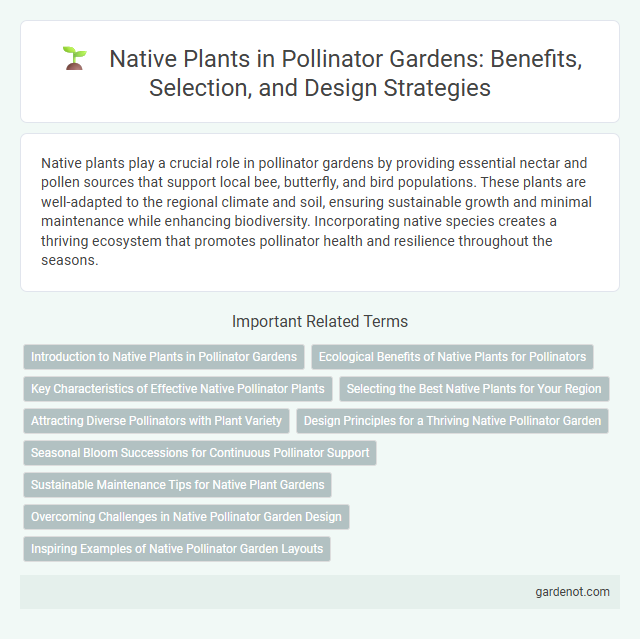Native plants play a crucial role in pollinator gardens by providing essential nectar and pollen sources that support local bee, butterfly, and bird populations. These plants are well-adapted to the regional climate and soil, ensuring sustainable growth and minimal maintenance while enhancing biodiversity. Incorporating native species creates a thriving ecosystem that promotes pollinator health and resilience throughout the seasons.
Introduction to Native Plants in Pollinator Gardens
Native plants play a crucial role in pollinator gardens by providing habitat-specific nectar and pollen essential for local pollinators like bees, butterflies, and hummingbirds. These plants are adapted to the local climate and soil conditions, requiring less water and maintenance while supporting biodiversity and ecological balance. Incorporating native species such as purple coneflower, milkweed, and goldenrod enhances pollinator health and promotes sustainable garden ecosystems.
Ecological Benefits of Native Plants for Pollinators
Native plants provide essential ecological benefits for pollinators by offering specialized nectar and pollen resources tailored to local species, enhancing their survival and reproduction rates. These plants support a diverse range of native pollinators like bees, butterflies, and hummingbirds, promoting biodiversity and ecosystem resilience. Incorporating native flora into pollinator gardens reduces the need for chemical inputs, preserving soil health and water quality.
Key Characteristics of Effective Native Pollinator Plants
Native pollinator plants feature deep root systems that enhance soil health and resilience, supporting long-term garden stability. Their vibrant, nectar-rich flowers bloom in succession, providing continuous food sources for diverse pollinators such as bees, butterflies, and hummingbirds. Adapted to local climate and soil conditions, these plants require minimal water and maintenance while maximizing ecological benefits.
Selecting the Best Native Plants for Your Region
Selecting the best native plants for your pollinator garden requires understanding the specific climate, soil type, and local pollinator species of your region. Native plants such as purple coneflower (Echinacea purpurea) in the Midwest or black-eyed Susan (Rudbeckia hirta) in the Southeast provide essential nectar and habitat for native bees, butterflies, and hummingbirds. Prioritizing species adapted to your area ensures higher survival rates, supports biodiversity, and promotes sustainable pollination.
Attracting Diverse Pollinators with Plant Variety
Native plants provide essential nectar and pollen sources tailored to local pollinators, enhancing garden biodiversity. Incorporating a variety of native flowering species ensures continuous blooms throughout the growing season, attracting bees, butterflies, hummingbirds, and other pollinators. This plant diversity supports a robust pollinator population by meeting different species' specific habitat and nutritional needs.
Design Principles for a Thriving Native Pollinator Garden
In designing a thriving native pollinator garden, select regional native plants such as milkweed, coneflowers, and bee balm to support local pollinators like monarch butterflies and native bees. Incorporate a diverse array of flowering species with staggered bloom times to provide continuous nectar and pollen throughout the growing season. Ensure habitat features such as sunny spots, sheltering shrubs, and undisturbed soil areas to promote nesting and breeding of native pollinators.
Seasonal Bloom Successions for Continuous Pollinator Support
Native plants with staggered bloom times create a continuous food source that supports pollinators throughout the growing season. Strategically selecting species such as purple coneflower (Echinacea purpurea) in summer, goldenrod (Solidago spp.) in fall, and early-blooming wild geranium (Geranium maculatum) in spring ensures year-round nectar and pollen availability. This seasonal bloom succession enhances habitat stability and promotes higher pollinator diversity and abundance.
Sustainable Maintenance Tips for Native Plant Gardens
Native plant gardens thrive with minimal water and fertilizer, making sustainable maintenance effective by mulching to retain soil moisture and suppress weeds. Pruning dead or diseased stems promotes healthy growth and encourages pollinator activity by ensuring abundant flowers. Incorporating diverse native species supports local biodiversity while reducing the need for chemical inputs and frequent interventions.
Overcoming Challenges in Native Pollinator Garden Design
Selecting native plants with proven adaptability to local soil and climate conditions is vital for overcoming challenges in native pollinator garden design. Incorporating a diverse range of flowering species that bloom sequentially throughout seasons ensures continuous food sources for pollinators. Managing invasive species and providing suitable nesting habitats enhances pollinator survival and promotes ecological balance.
Inspiring Examples of Native Pollinator Garden Layouts
Native pollinator gardens featuring milkweed, coneflowers, and goldenrod create vital habitats for monarch butterflies, bees, and other essential pollinators. Strategic layering of tall native grasses with low-growing wildflowers maximizes nectar sources and shelter throughout the growing season. Incorporating diverse bloom periods and structural variety replicates natural ecosystems, enhancing pollinator visitation and garden resilience.
Native plant Infographic

 gardenot.com
gardenot.com